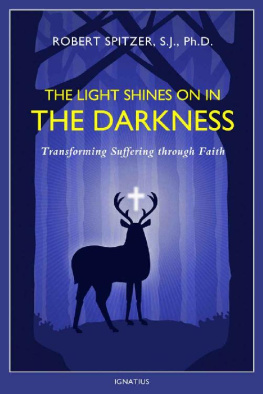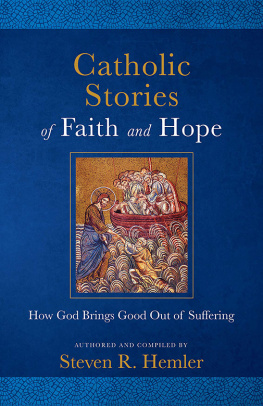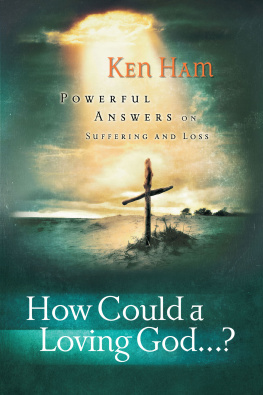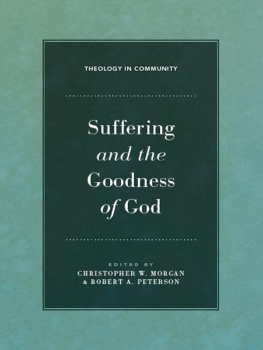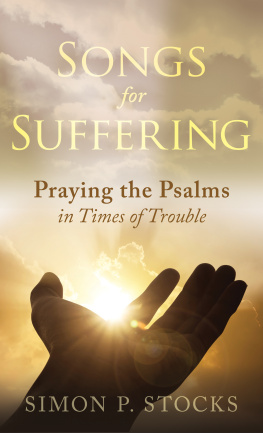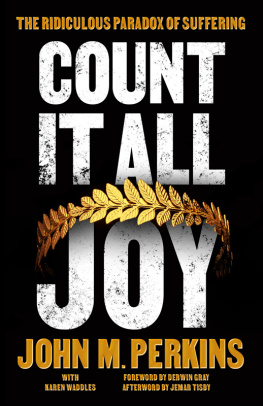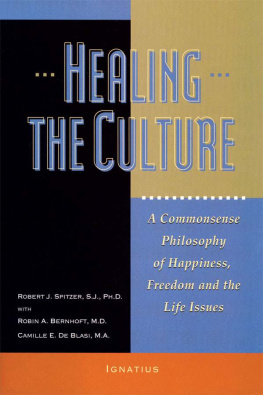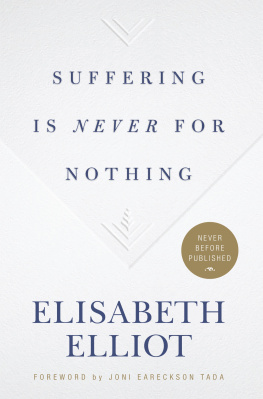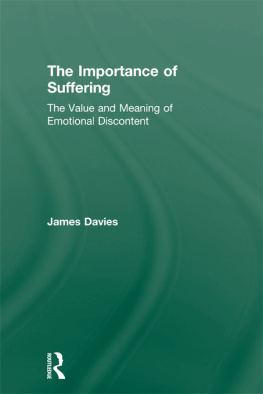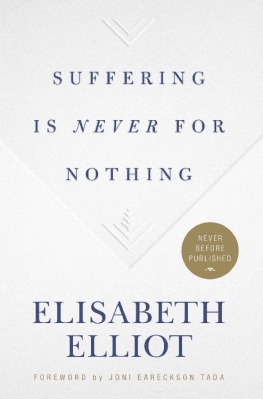THE LIGHT SHINES ON IN THE DARKNESS
Robert J. Spitzer, S.J., Ph.D.
THE LIGHT SHINES ON
IN THE DARKNESS
Transforming Suffering through Faith
Volume Four of the Quartet:
Happiness, Suffering, and Transcendence
IGNATIUS PRESS SAN FRANCISCO
Nihil obstat : Pia de Solenni, S.Th.d.
Imprimatur : + The Most Reverend Kevin J. Vann, J.C.D., D.D. Bishop, Diocese of Orange March 22, 2017
Unless otherwise indicated, Scripture quotations are from the Revised Standard Version of the BibleSecond Catholic Edition (Ignatius Edition), copyright 2006 National Council of the Churches of Christ in the United States of America. Used by permission. All rights reserved worldwide.
Cover design by John Herreid
2017 by Ignatius Press, San Francisco
All rights reserved
ISBN 978-1-58617-957-1 (PB)
ISBN 978-1-68149-764-8 (EB)
Library of Congress Control Number 2015948645
Printed in the United States of America
In loving memory of my mother and father, whose faith
in times of suffering inspired and edified me .
And to Joan Jacoby, Camille Pauley, and Jacinta Connall
who transformed every scholarly and administrative idea into books,
articles, and organizational realities .
In the beginning was the Word,
and the Word was with God, and the Word was God.
He was in the beginning with God;
all things were made through him, and without him was
not anything made that was made.
In him was life, and the life was the light of men.
The light shines in the darkness, and the darkness has not overcome it .
John 1:1-5
CONTENTS
Phase One:
Theological Preparation for Suffering
Foundations 1-3
First Foundation: Conviction about the Resurrection
(Eternal Life and Love)
Introduction
Second Foundation: Affirming the Unconditional Love of God
Introduction
Third Foundation: Recognizing Gods Presence in Our Suffering
Introduction
Phase Two:
Contending with Suffering in the Short-Term
Foundations 4-5
Fourth Foundation: Spontaneous Prayers in Times of Suffering
Introduction
Fifth Foundation: Mitigating Fear and Choosing Consolation
Introduction
Phase Three:
Benefitting from Suffering in the Long-Term
Foundations 6-9
Sixth Foundation: The Unity of Suffering and Love in Self-Sacrifice
Introduction
Seventh Foundation: Interior and Exterior Opportunities of Suffering
Introduction
Eighth Foundation: Offering Suffering as a Loving Self-Sacrifice
Introduction
Ninth Foundation: Following the Inspiration and Guidance of the Holy Spirit
Introduction
A Vexing Question and a Synopsis of the Relationship among Suffering, Freedom, Love, and God
Introduction
ACKNOWLEDGMENTS
I am most grateful to Joan Jacobywhose invaluable work transformed my thoughts once again into a full manuscriptfor typing multiple copies of each chapter, making helpful editing suggestions, and helping with research. I am particularly grateful for her appreciation of the subject, and her undying patience.
I am also grateful to Karlo Broussard and Juliana Gerace for their important input and assistance on preparing the manuscript, and to Joseph Miller for his editorial suggestions and encouragement.
I would also like to express my appreciation to the Board and friends of the Magis Institute who gave me the time and resources to complete this Quartet.
INTRODUCTION
We have taken a rather lengthy path through three volumes to get to this challenging issue within our consideration of transcendent happiness. In the first volume of the Quartet we queried into what the most meaningful kind of happiness and fulfillment might be, and resolved that three inner powers or capacities point the way to true, perfect, and lasting dignity and destinyempathy, conscience, and transcendent awareness. With respect to the third capacity, we discovered five distinct manifestations of transcendent awarenessperfect truth, perfect love, perfect justice / goodness, perfect beauty, and perfect home. When we viewed the implications of these powers in their relationship to one another, we concluded that the only way we could find eternal happiness is through a supreme interpersonal Beingwho is present in our five transcendental desires, and in the depths of our conscious and unconscious psyche. This led us to Saint Augustines declaration: For Thou hast made us for Thyselfand our hearts are restless until they rest in Thee!
We arrived at this conclusion by exploring four levels of happiness, proceeding from material-external happiness (Level One) to ego-comparative happiness (Level Two). We paused at Level Two because so many within our culture believe it to be true happiness, only to find themselves experiencing profound emptiness, jealousy, fear of loss of esteem, inferiority, superiority, ego-sensitivity, self-pity, resentment, and loneliness. We showed that the way out of these negative feelings of the comparison game is to move toward Levels Three and Four, which lead to a more pervasive, enduring, and deep purpose in lifecontribution, love, noble endeavor, transcendence, and communion with the Divine.
This led to another discovery: that Level Three happiness alone is not able to satisfy and fulfill us at the highest levels of our being. Though Level Three purpose in life can bring relief to the negative emotions of the comparison game, it cannot overcome other negative emotions connected with our desire for communion with a personal transcendent Being. We discovered that worldly purpose, love, and home could not overcome four negative states on the cosmic or transcendent level: cosmic emptiness, loneliness, alienation, and guilt. The meaning and love of this worldno matter how powerful and fullcannot satisfy our yearning for and calling to transcendent purpose and home. This was confirmed by a study of the American Psychiatric Association indicating that nonreligiously affiliated individuals have significantly greater anxiety, meaninglessness, familial tensions, past substance abuse, and suicide attempts than the religiously affiliated.
We then asked how cosmic emptiness, loneliness, alienation, and guilt can be alleviated. This led to a fivefold path taken by religiously affiliated people throughout the world, through association with a church, participation in sacred rites, the pursuit of transcendent wisdom, and engagement with the personal transcendent Being through prayer. This led to an examination of contemplative prayer and prayers of interior transformation along with special consideration of how to recognize and follow the inspiration and guidance of divine providence in our lives. We concluded that if the personal transcendent Being were unconditionally loving, we could be perfectly and eternally happy, which led to three questions:
1. Can we be sure that there is really a personal transcendent Being?
2. If so, is the personal transcendent Being unconditionally loving?
3. If so, then why does He allow suffering and evil within the world?
This led us to three additional explorations in three subsequent volumes.
In response to the first question, we examined several kinds of evidence for our transcendent nature and the existence of a personal transcendent Being in The Souls Upward Yearning: Clues to Our Transcendent Nature from Experience and Reason (Volume II). We began with our universal, fundamental, irreducible experience of the numen (a mysterious, fascinating, overwhelming, inviting wholly Other) manifest to both our conscious and unconscious psyche. We used Rudolf Ottos seminal study of this phenomenon, The Idea of the Holy ,
Yet the question still lingered: How do we know that these fundamental experiences originate in a real personal transcendent Being? This led us to an exploration of three kinds of external evidence: Bernard Lonergans proof of God, We found each kind of evidence to be probative in its own right, and in combination, to be mutually corroborative and complementary, validating the existence of God and a transcendent soul as reasonable and responsible.
Next page
